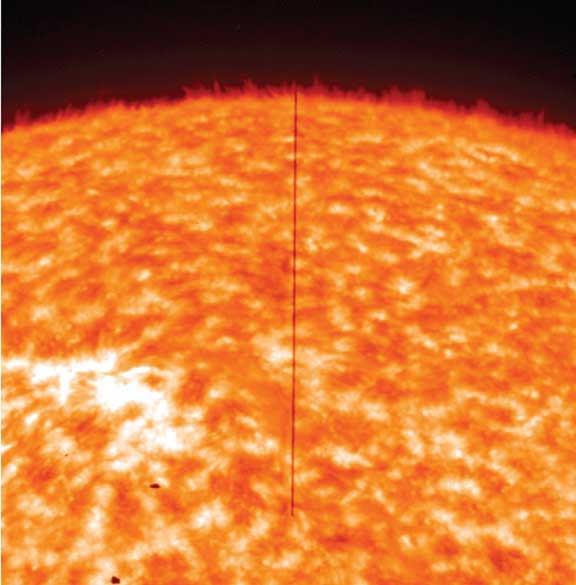Technology Development: Remote sensing of magnetic fields requires both precision spectroscopy and precision polarimetry (spectro-polarimetry). NASA led an international team that developed the Chromospheric Lyman-Alpha Spectropolarimeter (CLASP)—the first instrument to achieve the spectro-polarimetry needed for magnetic field measurements of the outer layers of the solar atmosphere. Previous solar magnetic field measurements were restricted to regions near the sun’s surface because adequate spectro-polarimetry has been (until now) technically feasible only in visible and nearinfrared light. In these regions, the forces associated with gas pressure dominate the forces associated with magnetic fields. However, in the outer solar atmosphere (the transition region and corona) the magnetic fields dominate.
Numerical extrapolation to determine magnetic fields in the outer layers of the solar atmosphere (where magnetic pressure dominates) from observations of fields in the photosphere (where gas pressure dominates) is not sufficiently accurate to understand and predict key physical processes. CLASP provided the first measurement of the scattering polarization of light in the Lyman-alpha spectral line, Ultra-Violet light that is formed in the upper chromosphere and transition region of the sun. This polarization is modified by the local magnetic field; hence CLASP’s detection of this polarization is a powerful tool for measuring the magnetic field in the upper chromosphere. The modification of the linear polarization in the Lyman-alpha spectral line is small, only on the order of 0.5%. Measurement of this small change in polarization requires a well calibrated instrument, maintenance of stable pointing during the observations, as well as low-noise cameras. The NASA CLASP team developed the low-noise CLASP camera system and an accompanying flexible avionics package that can be modified to accommodate other suborbital missions.
Impact: Space weather—the dynamic electrical and magnetic conditions in the Earth’s outer space environment—can greatly affect human endeavors, disrupting electric power grids on Earth, interfering with high-frequency radio communications and Global Positioning System (GPS) navigation systems, and damaging Earth-orbiting spacecraft. Most of the solar variability and solar eruptions affecting space weather originate in the sun’s outer atmosphere regions. Therefore, to understand space weather it is critical to achieve direct measurements of the dominant force in these regions— the magnetic fields. By achieving ultraviolet spectropolarimetry in the transition region and corona, CLASP has shown how to achieve direct magnetic field measurements that will enable scientists to understand solar processes that affect life on Earth.
Status and Future Plans: CLASP launched from White Sands Missile Range aboard a NASA Sounding Rocket Program Black Brant IX vehicle on September 3, 2015. The flight attitude control system proved very stable during the period of observations, with less than 0.1” jitter and 1” drift over the five minutes of data accumulation. The NASA-developed camera system achieved a six-electron root mean square (RMS) noise during flight. The initial data indicate that CLASP detected scattering polarization in Lyman-alpha. Interpretation of these polarization modulation observations in terms of the solar magnetic field and the implications for the theory of structures in the solar atmosphere is being prepared for publication in a peer-reviewed journal. Accomplishment of these challenging measurements provides a path to routinely obtaining magnetic field measurements of the solar atmosphere from a future orbital platform.
Sponsoring Organization: The CLASP instrument is a partnership between NASA; the Japan Aerospace Exploration Agency (JAXA); the National Astronomical Observatory of Japan (NAOJ); the Instituto de Astrofísica de Canarias in Santa Cruz de Tenerife, Spain (IAC); and the Institut d’Astrophysique Spatiale in Paris (IAS). The optical instrument was developed, built and calibrated by NAOJ. The Heliophysics Division’s H-TIDeS low-cost access to space (LCAS) program provided funding for NASA’s contribution to CLASP, which was developed by PI, Dr. Amy Winebarger, at Marshall Space Flight Center (MSFC).



































